Find out what the propagation and garden teams have been up to this week.
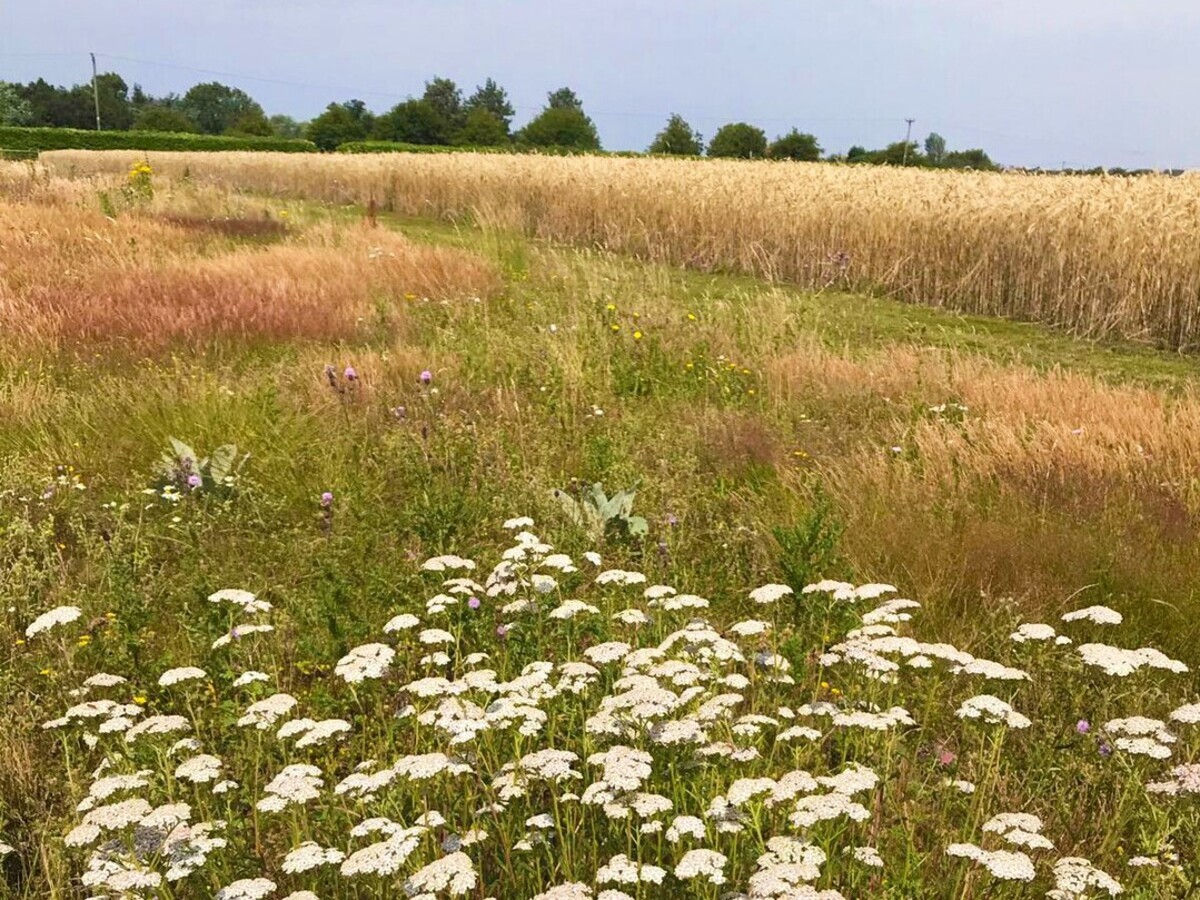
What happened when we stopped mowing the grass?
A naturalistic planting style is one key element of Beth’s work. She grew plants as nature dictated, finding the conditions in which they would be happiest, right plant, right place.
Throughout the Gardens, you’ll find plants growing in the conditions they like best. This sustainable approach to planting means plants thrive. Our gardeners are very much needed of course! But, in many areas, nature lends a helping hand. In the Gravel Garden for example, Beth purposely chose plants that self-seed, providing a fresh tapestry of plants year after year.
Beth continuously strived to deepen her knowledge. She never stopped learning, and in the spirit of this, we are always adding to and developing the gardens. It famously never stays the same.
So, when our estate supervisor, Jason suggested back in March not mowing the field adjacent to our main car park, used as an overflow parking area and picnics, the potential for more experimentation was tempting. What would happen? Which plants would grow? What wildlife would thrive? Would we see greater diversity on the edge of Beth’s Gardens than can be seen in neighbouring unmown areas?
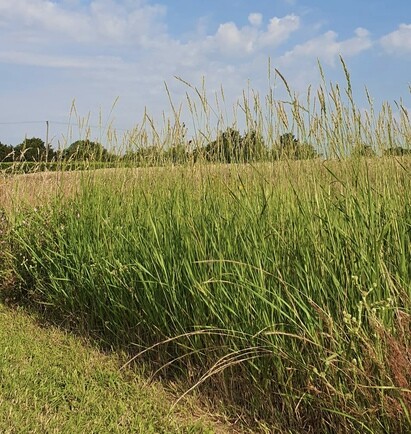
What has appeared?
The results have been incredible. Within just a matter of a few weeks, where previously there was a flat and uninspiring carpet of green, there now exists, and thrives with no help from us, a multi-dimensional mosaic of colour, shape, texture creating flowing movement, alive with insects and visiting birds - the count of which rises daily.
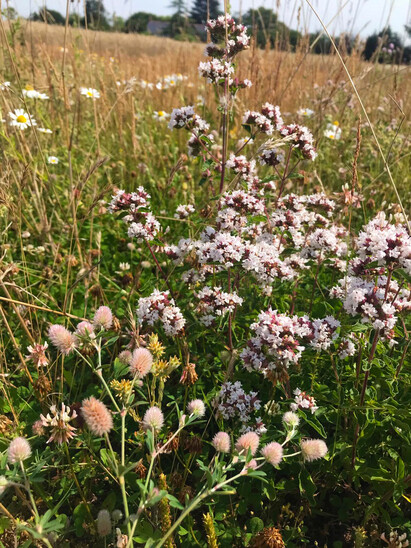
Marjoram Origanum vulgare and Haresfoot clover Trifolium arvense
The plants which have sprung up in our new dry grassland are those found naturally in this sort of location. Heavy London clay topped with proto-Thames sands and gravels, thrust into a ridge by the continental collision which formed Europe’s Mountain ranges, such as the Alps and the Pyrenees. These soils are droughty, with bare patches in hot dry periods. So not typical meadows, but wholly natural parched grasslands, perched on the Essex Alps in the driest part of the country.
Where have the plants come from?
We estimate that there are 50-60 plants in total, in our unmown grassland, of which 15-20 are grasses. These plants come from different sources:
- Native plants of the Essex Alps dry grassland (eg common cudweed, hare’s foot clover)
- Other reasonably local natives, including coastal specialists such as narrow-leaved bird’s-foot-trefoil
- Other native species but of unknown provenance, arriving perhaps on visiting vechiles or farm machinery. (e.g. rest-harrow)
- Grasses sown in after restoration work (red fescue and ryegrasses)
- Plants that have presumably hopped over the garden fence, by one means or another (eg hollyhock, marjoram)
What has appeared in such a short time frame is a truly unique multicultural plant community, the like of which Beth would surely have approved and indeed brought into her own ideas when planting her own garden.
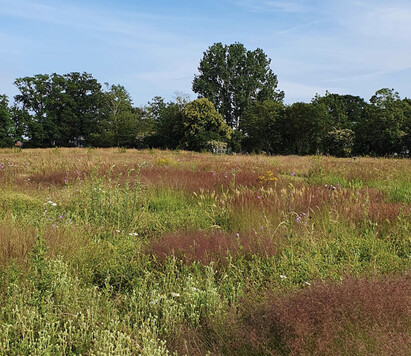
The diversity of plants we are seeing may be due in part to its proximity to Beth’s gardens, and next year we will be able to see what settles and persists in the mosaic.
In terms of ecological benefit and overall sustainability this Essex Grassland dovetails nicely with our ethos and principles at Beth’s. And what’s more, the picnic benches are adjacent to the Grassland project, so you can enjoy a bite to eat and drink from our tearoom and a wander through the Grassland when you come to visit.
We will update the lists below as new species are spotted.
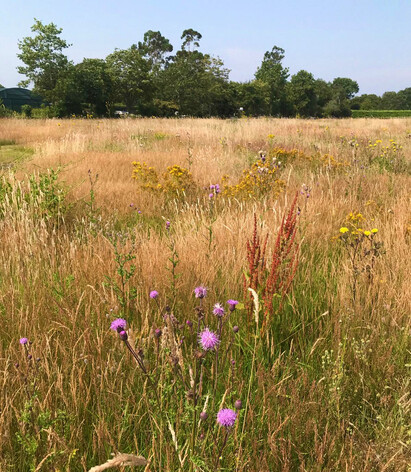
Creeping thistle and common sorrel
How to create your own rewilded areas
Just leaving things be, will mean things grow. ‘No-mow May’ has been an important boost to wildlife in the UK and we plan for our experiment to contribute to this movement and help demonstrate the improvement in species diversity.
According to the office of National Statistics, in 2019, private gardens in the UK covered about 1,289,573 acres.
If everyone who has a garden allowed 10% of it to be left to nature, we could potentially be making more than 100,000 acres more plant and wildlife friendly.
Not mowing is just one way to encourage species diversity and it only takes a few weeks for an unmown area to look wonderful:
- In our experiment, winding paths were mown, to make exploration possible and inviting!
- You can actively encourage wildflowers by throwing some seed in the area in early spring
- Leave wider wild areas around e.g., trees – create smaller no-mow areas if you’re not keen on a completely unmown approach
- When you decide to cut it again, perhaps in September, you’ll need a strimmer rather than a lawn mower and you may initially end up with area that looks less attractive because the sun has not been able to reach the ground but rest assured that it will quickly recover.
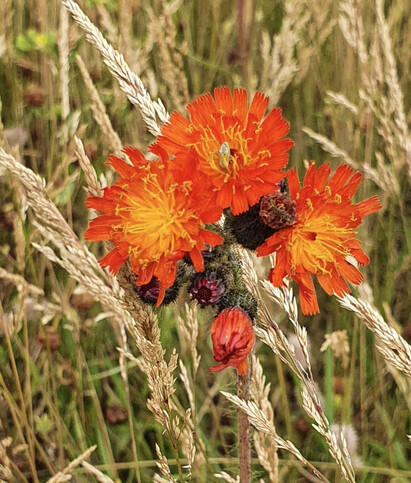
Pilosella which we believe has 'hopped over the garden fence from the Gravel Garden'
A list of the some of the plants identified, updated August 2021
Native plants typical of the Essex Alps dry grassland
Common cudweed (Filago germanica)
Hare’s-foot clover (Trifolium arvense)
Yarrow (Achillea millefolium)
Common fleabane (Pulicaria dysenterica)
Hop trefoil (Trifolium campestre)
Common Bird’s-foot-trefoil (Lotus corniculatus)
Field madder (Sherardia arvensis)
Common Stork’s-bill (Erodium cicutarium)
Nodding thistle (Carduus nutans)
Black Knapweed (Centaurea nigra)
Knotted hedge-parsley (Torilis nodosa)
Buck’s-horn plantain (Plantago coronopus)
Dove’s-foot crane’s-bill (Gearanium molle)
Sand spurrey (Spergularia rubra)
Mouse-eared hawkweed (Pilosella officinarum)
Spiked sedge (Carex spicata)
Rat’s-tail fescue (Vulpia myuros)
Creeping bent (Agrostis stolonifera)
Common bent (Agrostis capillaris)
Soft brome (Bromus hordeaceus)
Small Timothy (Phleum bertolonii)
Yorkshire-fog (Holcus lanatus)
Other reasonably local natives, including coastal specialists
Narrow-leaved bird’s-foot-trefoil (Lotus tenuis)
Common sorrel (Rumex acetosa)
Tufted vetch (Vicia cracca)
Perforate St John’s-wort (Hypericum perforatum)
Meadow vetchling (Lathyrus pratensis)
White clover (Trifolium repens)
Daisy (Bellis perennis)
Cock’s-foot (Dactylis glomerata)
False oat-grass (Arrhenatherum elatius)
Other native species but of unknown provenance, arriving perhaps on visiting vehicles or farm machinery
Rest-harrow (Ononis repens)
Ruderal (weedy) species that colonise rapidly and naturally
Creeping thistle (Cirsium arvense)
Spear thistle (Cirsium vulgare)
Common mallow (Malva sylvestris)
Hedgerow crane’s-bill (Geranium pyrenaicum)
Dandelion (Taraxacum officinale)
Plants that have presumably hopped over the garden fence, by one means or another
Hollyhock (Alcea rosea)
Marjoram (Origanum vulgare)
Caucasian germander (Teucrium hircanicum)
Mullein (Verbascum sp)
Pink sorrel (Oxalis articulata)
Orange hawkweed (Pilosella aurantiaca)
Grasses sown in after restoration work
Red fescue (Festuca rubra)
Perennial rye-grass (Lolium perenne)
A list of the some of the insects identified (survey currently underway, August 2021)
With sincere thanks to our wildlife expert, Dr Chris Gibson, for his assistance and support.

An interesting article.